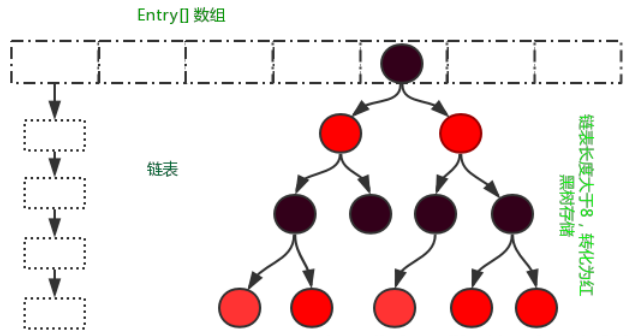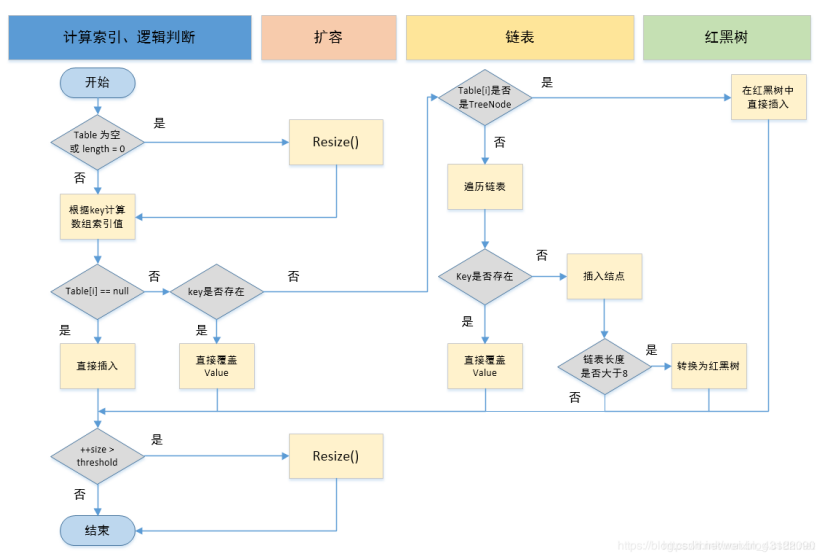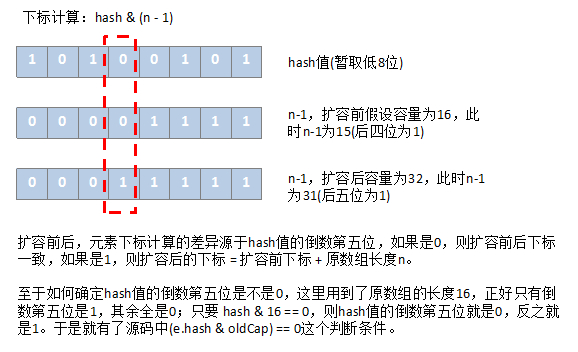Hash? Map? HashMap?
Hash
又叫哈希、散列,它的作用是使用有限的特征去映射无限的信息,这个过程需要借助算法来实现,这个算法就叫做哈希算法。
hash算法没有固定公式,可以理解为一种思想。
hash碰撞
既然输入是无限的,而我们使用的特征空间是有限的,那么不管使用的hash算法多么复杂和精妙,都有可能出现不同的输入信息计算出的特征是相同的,这就是hash碰撞,也叫hash冲突。比如不同的java对象,调用Object类的hashCode()方法,就有可能计算出相同的hash值。
Map
一个java接口,用来保存映射关系,这里说的映射关系,指的是 <key, value>形式键值对,具体怎么保存,需要由实现类来实现。
HashMap
Map接口的实现类,它内部会初始化一个Node结点类型的数组,k-v键值对就保存在Node中。这些Node结点在数组中的位置,是通过对k-v中的key进行hash运算,根据计算出的值来确定的,所以叫做HashMap。
HashMap的结构
以JDK 1.8为例,HashMap内部定义了一个 Node<K,V>[] 类型的成员变量,这是一个结点数组。而定义Node<K,V>的部分源码如下:
static class Node<K,V> implements Map.Entry<K,V> {
final int hash;
final K key;
V value;
Node<K,V> next;
Node(int hash, K key, V value, Node<K,V> next) {
this.hash = hash;
this.key = key;
this.value = value;
this.next = next;
}
public final K getKey() { return key; }
public final V getValue() { return value; }
public final String toString() { return key + "=" + value; }
可以看到Node<K,V>对象中保存了我们要放入的 key,value,以及一个hash值,一个指向下一个结点的指针;而这些属性都是通过构造函数传入的。
除了数组以外,遇到hash冲突时,HashMap使用了链表的方式存储hash冲突的元素,当链表数量超过阈值时,还可能会对链表进行树化,转换成红黑树结构来存储。整体结构图如下(实际红黑树叶子结点必须为黑色,此处仅为示意):

HashMap的构造方法
public HashMap(int initialCapacity, float loadFactor) {
if (initialCapacity < 0)
throw new IllegalArgumentException("Illegal initial capacity: " +
initialCapacity);
if (initialCapacity > MAXIMUM_CAPACITY)
initialCapacity = MAXIMUM_CAPACITY;
if (loadFactor <= 0 || Float.isNaN(loadFactor))
throw new IllegalArgumentException("Illegal load factor: " +
loadFactor);
this.loadFactor = loadFactor;
this.threshold = tableSizeFor(initialCapacity);
}
构造方法中,并没有对存放数据的Node数组进行初始化,而仅仅是确定了两个属性 loadFactor 和 threshold。当我们执行 put 方法放入元素时,检测到Node数组为null,才会调用 resize方法进行扩容,完成数组创建。
loadFactor:加载因子,默认值为0.75;
threshold:扩容阈值,计算方式为 容量 * 加载因子。容量默认为16,也就是说扩容阈值默认为12。
当我们在HashMap的构造函数中传入了初始容量 initialCapacity时,threshold会被计算出来,比如传入20,计算出的初始 threshold就是32;传入32,则算出来也是32;也就是说,tableSizeFor方法计算结果总是>=初始容量的最近的2的幂。这时的threshold仅仅起一个计数的所用,用来代表应该分配的初始容量,正确的 threshold (扩容阈值)会在首次扩容的时候确定下来(容量 * 加载因子)。
HashMap的put方法
public V put(K key, V value) {
return putVal(hash(key), key, value, false, true);
}
final V putVal(int hash, K key, V value, boolean onlyIfAbsent,
boolean evict) {
Node<K,V>[] tab; Node<K,V> p; int n, i;
//数组为空或长度为0,先扩容。
if ((tab = table) == null || (n = tab.length) == 0)
n = (tab = resize()).length;
//计算下标,槽为空,则直接放入新节点。
if ((p = tab[i = (n - 1) & hash]) == null)
tab[i] = newNode(hash, key, value, null);
else {
Node<K,V> e; K k;
//槽中已有元素,判断是否为相同的key,是则直接覆盖。
if (p.hash == hash &&
((k = p.key) == key || (key != null && key.equals(k))))
e = p;
//如果不是相同key,但是已有元素为树结点,则进行红黑树结点的覆盖/插入。
else if (p instanceof TreeNode)
e = ((TreeNode<K,V>)p).putTreeVal(this, tab, hash, key, value);
//走到这里,说明是已有元素为链表结点,遍历链表进行结点覆盖/插入。
else {
for (int binCount = 0; ; ++binCount) {
if ((e = p.next) == null) {
p.next = newNode(hash, key, value, null);
//TREEIFY_THRESHOLD默认为8,binCount等于7时,此时链表上已经有9个结点,需要进行树化。
if (binCount >= TREEIFY_THRESHOLD - 1) // -1 for 1st
treeifyBin(tab, hash);
break;
}
if (e.hash == hash &&
((k = e.key) == key || (key != null && key.equals(k))))
break;
p = e;
}
}
if (e != null) { // existing mapping for key
V oldValue = e.value;
if (!onlyIfAbsent || oldValue == null)
e.value = value;
afterNodeAccess(e);
return oldValue;
}
}
++modCount;
if (++size > threshold)
resize();
afterNodeInsertion(evict);
return null;
}
put方法中确定下标使用的运算是:(n - 1) & hash,相当于是拿hash值对数组长度进行%取模运算,只是直接使用位运算更加高效。
这里的hash则是通过调用key的hashCode方法,然后位运算得到:
static final int hash(Object key) {
int h;
return (key == null) ? 0 : (h = key.hashCode()) ^ (h >>> 16);
}
用流程图的方式描述 put方法的流程如下:

HashMap扩容
由put方法的流程可知,调用resize方法扩容出现在首次put,以及put后元素个数大于扩容阈值时,扩容的核心操作是创建一个更大的数组(HashMap采用2倍扩容),然后把原来的元素放到新数组中正确的位置上。源码如下:
final Node<K,V>[] resize() {
Node<K,V>[] oldTab = table;
int oldCap = (oldTab == null) ? 0 : oldTab.length;
int oldThr = threshold;
int newCap, newThr = 0;
if (oldCap > 0) {
if (oldCap >= MAXIMUM_CAPACITY) {
threshold = Integer.MAX_VALUE;
return oldTab;
}
//如果Node数组已存在,2倍扩容得到新数组长度。
else if ((newCap = oldCap << 1) < MAXIMUM_CAPACITY &&
oldCap >= DEFAULT_INITIAL_CAPACITY)
newThr = oldThr << 1; // double threshold
}
//初始化,构造函数中指定初始容量走此逻辑
else if (oldThr > 0) // initial capacity was placed in threshold
newCap = oldThr;
//初始化,构造函数中未指定初始容量走此逻辑
else { // zero initial threshold signifies using defaults
newCap = DEFAULT_INITIAL_CAPACITY;
newThr = (int)(DEFAULT_LOAD_FACTOR * DEFAULT_INITIAL_CAPACITY);
}
//确保扩容阈值被计算
if (newThr == 0) {
float ft = (float)newCap * loadFactor;
newThr = (newCap < MAXIMUM_CAPACITY && ft < (float)MAXIMUM_CAPACITY ?
(int)ft : Integer.MAX_VALUE);
}
threshold = newThr;
@SuppressWarnings({"rawtypes","unchecked"})
Node<K,V>[] newTab = (Node<K,V>[])new Node[newCap];
table = newTab;
if (oldTab != null) {
for (int j = 0; j < oldCap; ++j) {
Node<K,V> e;
if ((e = oldTab[j]) != null) {
oldTab[j] = null;
//如果原来的结点为单结点,直接重新计算hash值,放到新数组中。
if (e.next == null)
newTab[e.hash & (newCap - 1)] = e;
/*
如果原来的结点为树形结点,进入树的迁移逻辑,如果迁移后发现节点数<=解除树化阈值
(UNTREEIFY_THRESHOLD,默认为6),则将红黑树拆成链表结构。
*/
else if (e instanceof TreeNode)
((TreeNode<K,V>)e).split(this, newTab, j, oldCap);
//链表走此逻辑。
else { // preserve order
Node<K,V> loHead = null, loTail = null;
Node<K,V> hiHead = null, hiTail = null;
Node<K,V> next;
do {
next = e.next;
/*
原链表中结点的hash值重新加算后,可能会拆解为两个链表,一个头结点还在原下标处(低处),而另一个头结点的下
标为原下标+原数组长度(高处),这里(e.hash & oldCap) == 0成立,则表示这个结点应该继续待在低处,反之在高处。
*/
if ((e.hash & oldCap) == 0) {
if (loTail == null)
loHead = e;
else
loTail.next = e;
loTail = e;
}
else {
if (hiTail == null)
hiHead = e;
else
hiTail.next = e;
hiTail = e;
}
} while ((e = next) != null);
if (loTail != null) {
loTail.next = null;
newTab[j] = loHead;
}
if (hiTail != null) {
hiTail.next = null;
newTab[j + oldCap] = hiHead;
}
}
}
}
}
return newTab;
}
关于(e.hash & oldCap) == 0的理解:

HashMap的get方法
public V get(Object key) {
Node<K,V> e;
return (e = getNode(hash(key), key)) == null ? null : e.value;
}
final Node<K,V> getNode(int hash, Object key) {
Node<K,V>[] tab; Node<K,V> first, e; int n; K k;
if ((tab = table) != null && (n = tab.length) > 0 &&
(first = tab[(n - 1) & hash]) != null) {
//如果对应下标的结点就是,则直接返回。
if (first.hash == hash && // always check first node
((k = first.key) == key || (key != null && key.equals(k))))
return first;
//如果对应下标的结点不是,但它后面还有结点。
if ((e = first.next) != null) {
//如果是树结构,在树中查找。
if (first instanceof TreeNode)
return ((TreeNode<K,V>)first).getTreeNode(hash, key);
//如果是链表结构,则遍历查找。
do {
if (e.hash == hash &&
((k = e.key) == key || (key != null && key.equals(k))))
return e;
} while ((e = e.next) != null);
}
}
return null;
}
ConcurrentHashMap
ConcurrentHashMap是HashMap的线程安全版本,它的基本结构与HashMap一致,都使用了数组+链表+红黑树的结构,不过ConcurrentHashMap使用了volatile变量 + CAS原子操作 + synchronized锁来保证线程安全。
ConcurrentHashMap中使用了一个名为sizeCtl的整形变量来控制Node数组的状态(类似的控制变量在线程池中也有使用)。
sizeCtl默认为0,构造函数中被设置为数组的初始容量,数组初始化过程中为-1,初始化完毕为扩容阈值,扩容过程中为 -(1+扩容线程数)。
ConcurrentHashMap的putVal方法
final V putVal(K key, V value, boolean onlyIfAbsent) {
if (key == null || value == null) throw new NullPointerException();
int hash = spread(key.hashCode());
int binCount = 0;
//整个put操作自旋
for (Node<K,V>[] tab = table;;) {
Node<K,V> f; int n, i, fh;
//初始化Node数组
if (tab == null || (n = tab.length) == 0)
tab = initTable();
//计算出的下标处无结点,CAS操作进行赋值
else if ((f = tabAt(tab, i = (n - 1) & hash)) == null) {
if (casTabAt(tab, i, null,
new Node<K,V>(hash, key, value, null)))
break; // no lock when adding to empty bin
}
//如果当前下标处结点的hash为-1,则说明数组正在扩容,因为扩容过程中每处理完一个桶,都会
//将原数组该桶的位置放入一个ForwardingNode结点,该节点hash写死为-1。此时需要协助扩容。
else if ((fh = f.hash) == MOVED)
tab = helpTransfer(tab, f);
else {
V oldVal = null;
//此时说明该下标处有结点,直接把该结点锁住,相当于锁住了整个桶(以该节点为首的链表或树)。
synchronized (f) {
if (tabAt(tab, i) == f) {
if (fh >= 0) {
binCount = 1;
for (Node<K,V> e = f;; ++binCount) {
K ek;
if (e.hash == hash &&
((ek = e.key) == key ||
(ek != null && key.equals(ek)))) {
oldVal = e.val;
if (!onlyIfAbsent)
e.val = value;
break;
}
Node<K,V> pred = e;
if ((e = e.next) == null) {
pred.next = new Node<K,V>(hash, key,
value, null);
break;
}
}
}
else if (f instanceof TreeBin) {
Node<K,V> p;
binCount = 2;
if ((p = ((TreeBin<K,V>)f).putTreeVal(hash, key,
value)) != null) {
oldVal = p.val;
if (!onlyIfAbsent)
p.val = value;
}
}
}
}
if (binCount != 0) {
if (binCount >= TREEIFY_THRESHOLD)
treeifyBin(tab, i);
if (oldVal != null)
return oldVal;
break;
}
}
}
//增加结点计数,可能涉及到并发修改、扩容、协助扩容等场景。
addCount(1L, binCount);
return null;
}
扩容的核心方法transfer(迁移)
private final void transfer(Node<K,V>[] tab, Node<K,V>[] nextTab) {
int n = tab.length, stride;
//确定扩容步长,最小步长为16,即将原数组从后往前每16个桶划分为一段,每个线程单次只负责一个分段的结点迁移。
if ((stride = (NCPU > 1) ? (n >>> 3) / NCPU : n) < MIN_TRANSFER_STRIDE)
stride = MIN_TRANSFER_STRIDE; // subdivide range
//首个负责扩容的线程初始化新数组,长度为原数组长度2倍
if (nextTab == null) { // initiating
try {
@SuppressWarnings("unchecked")
Node<K,V>[] nt = (Node<K,V>[])new Node<?,?>[n << 1];
nextTab = nt;
} catch (Throwable ex) { // try to cope with OOME
sizeCtl = Integer.MAX_VALUE;
return;
}
nextTable = nextTab;
transferIndex = n;
}
int nextn = nextTab.length;
ForwardingNode<K,V> fwd = new ForwardingNode<K,V>(nextTab);
boolean advance = true;
boolean finishing = false; // to ensure sweep before committing nextTab
for (int i = 0, bound = 0;;) {
Node<K,V> f; int fh;
while (advance) {
int nextIndex, nextBound;
//判断当前分段(比如线程分配到的16个桶)是否遍历完毕
if (--i >= bound || finishing)
advance = false;
//判断是否还有可以分配的区域
else if ((nextIndex = transferIndex) <= 0) {
i = -1;
advance = false;
}
//线程通过CAS操作获取自己负责的分段,设置边界下标bound和用于循环的下标i
else if (U.compareAndSwapInt
(this, TRANSFERINDEX, nextIndex,
nextBound = (nextIndex > stride ?
nextIndex - stride : 0))) {
bound = nextBound;
i = nextIndex - 1;
advance = false;
}
}
//判断扩容结束,即整个自旋操作的出口
if (i < 0 || i >= n || i + n >= nextn) {
int sc;
if (finishing) {
nextTable = null;
table = nextTab;
sizeCtl = (n << 1) - (n >>> 1);
return;
}
if (U.compareAndSwapInt(this, SIZECTL, sc = sizeCtl, sc - 1)) {
if ((sc - 2) != resizeStamp(n) << RESIZE_STAMP_SHIFT)
return;
//最后一个扩容的线程将finishing改为true
finishing = advance = true;
i = n; // recheck before commit
}
}
//如果元素组该桶是空的,直接替换为ForwardingNode结点,表示该桶处理完毕。
else if ((f = tabAt(tab, i)) == null)
advance = casTabAt(tab, i, null, fwd);
else if ((fh = f.hash) == MOVED)
advance = true; // already processed
else {
//扩容操作需要锁住当前桶,即以当前下标结点为首的链表或红黑树。
synchronized (f) {
if (tabAt(tab, i) == f) {
Node<K,V> ln, hn;
if (fh >= 0) {
int runBit = fh & n;
Node<K,V> lastRun = f;
for (Node<K,V> p = f.next; p != null; p = p.next) {
int b = p.hash & n;
if (b != runBit) {
runBit = b;
lastRun = p;
}
}
if (runBit == 0) {
ln = lastRun;
hn = null;
}
else {
hn = lastRun;
ln = null;
}
for (Node<K,V> p = f; p != lastRun; p = p.next) {
int ph = p.hash; K pk = p.key; V pv = p.val;
if ((ph & n) == 0)
ln = new Node<K,V>(ph, pk, pv, ln);
else
hn = new Node<K,V>(ph, pk, pv, hn);
}
setTabAt(nextTab, i, ln);
setTabAt(nextTab, i + n, hn);
setTabAt(tab, i, fwd);
advance = true;
}
else if (f instanceof TreeBin) {
TreeBin<K,V> t = (TreeBin<K,V>)f;
TreeNode<K,V> lo = null, loTail = null;
TreeNode<K,V> hi = null, hiTail = null;
int lc = 0, hc = 0;
for (Node<K,V> e = t.first; e != null; e = e.next) {
int h = e.hash;
TreeNode<K,V> p = new TreeNode<K,V>
(h, e.key, e.val, null, null);
if ((h & n) == 0) {
if ((p.prev = loTail) == null)
lo = p;
else
loTail.next = p;
loTail = p;
++lc;
}
else {
if ((p.prev = hiTail) == null)
hi = p;
else
hiTail.next = p;
hiTail = p;
++hc;
}
}
ln = (lc <= UNTREEIFY_THRESHOLD) ? untreeify(lo) :
(hc != 0) ? new TreeBin<K,V>(lo) : t;
hn = (hc <= UNTREEIFY_THRESHOLD) ? untreeify(hi) :
(lc != 0) ? new TreeBin<K,V>(hi) : t;
setTabAt(nextTab, i, ln);
setTabAt(nextTab, i + n, hn);
setTabAt(tab, i, fwd);
advance = true;
}
}
}
}
}
}
ConcurrentHashMap的get方法
public V get(Object key) {
Node<K,V>[] tab; Node<K,V> e, p; int n, eh; K ek;
int h = spread(key.hashCode());
if ((tab = table) != null && (n = tab.length) > 0 &&
(e = tabAt(tab, (n - 1) & h)) != null) {
//key相同则直接返回
if ((eh = e.hash) == h) {
if ((ek = e.key) == key || (ek != null && key.equals(ek)))
return e.val;
}
//如果数组正在扩容,待当前桶扩容完毕后,调用ForwardingNode的find方法去新数组里找。
else if (eh < 0)
return (p = e.find(h, key)) != null ? p.val : null;
//往下依次遍历
while ((e = e.next) != null) {
if (e.hash == h &&
((ek = e.key) == key || (ek != null && key.equals(ek))))
return e.val;
}
}
return null;
}
参考资料:https://blog.csdn.net/qq_17555249/article/details/107855623




















 483
483











 被折叠的 条评论
为什么被折叠?
被折叠的 条评论
为什么被折叠?








